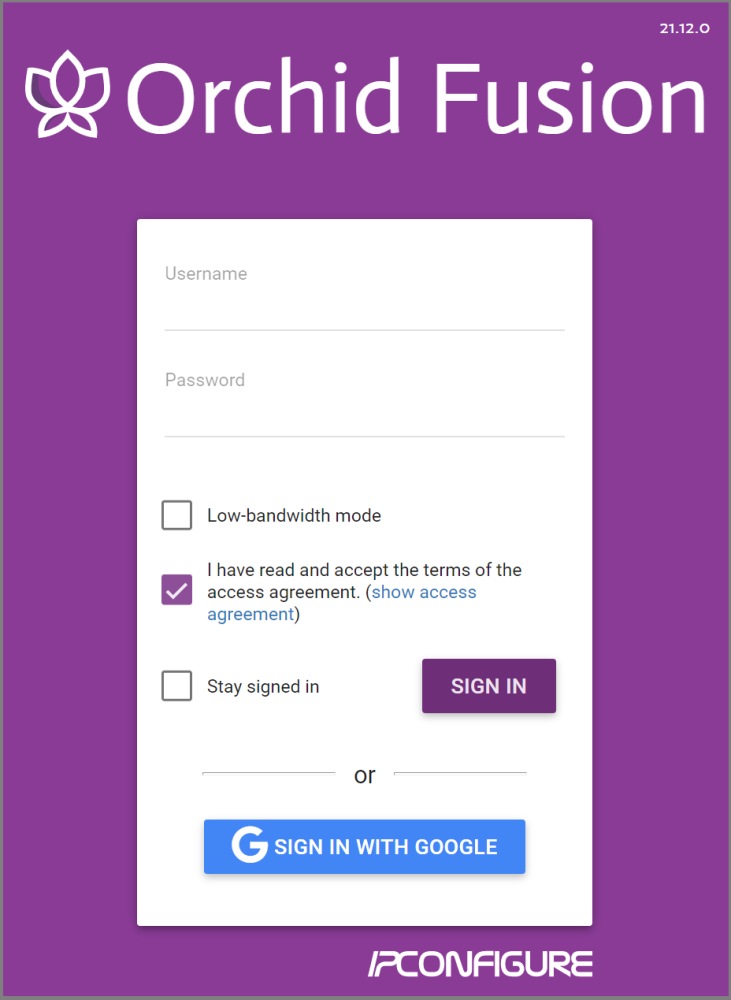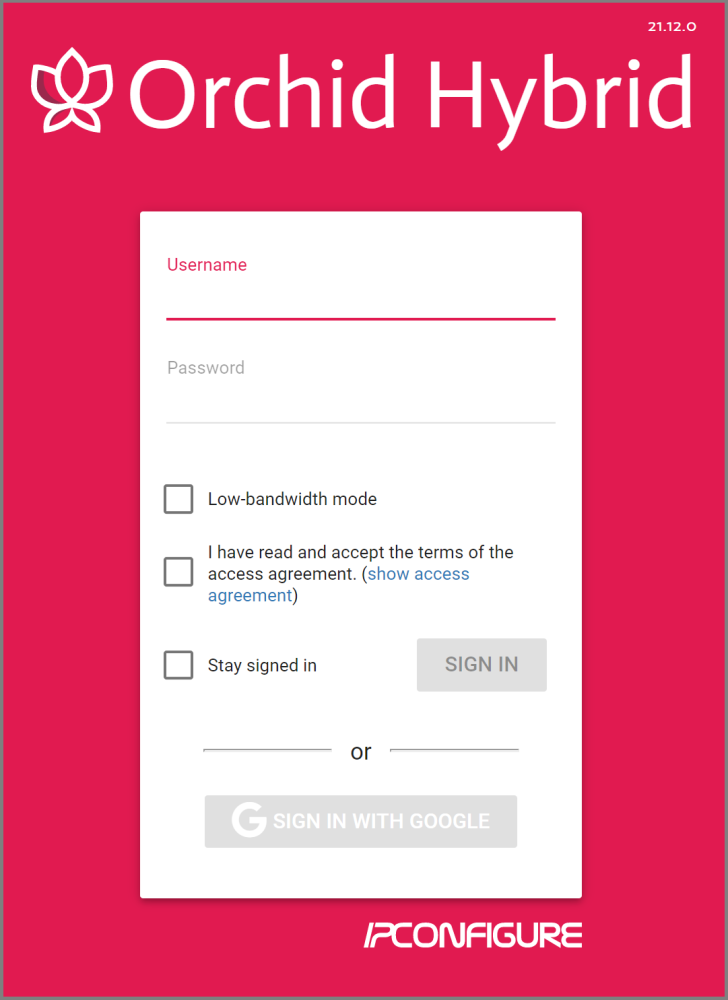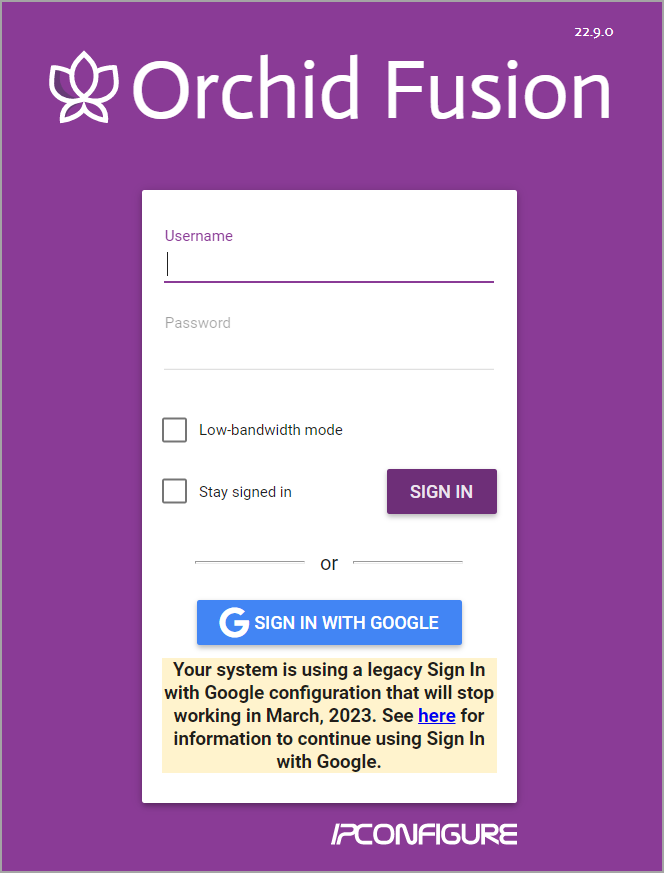With the release of version 2.10, Orchid Fusion/Hybrid VMS has added more ways to sign in, and will allow mixed authentication modes. So, Administrators may enable multiple sign in modes on the same system.
Orchid Fusion/Hybrid VMS supports each of the following external authentication providers:
- Active Directory
- Azure Active Directory
- FreeIPA
Accessing the Sign In Screen
Fusion
- To open Orchid Fusion VMS on a client device, type the IP address of the Orchid Fusion VMS server in the web browser address bar. If you are opening Orchid Fusion VMS on the Orchid Fusion VMS server itself, you may type localhost:8080 in the web browser address bar (where 8080 is the web server port number). You may also use the Orchid Fusion VMS link in the system menu or the desktop icon in Windows, or the Fusion icon in the Applications list in Linux.
- You will be prompted to sign into Orchid Fusion VMS. (Your Orchid Fusion VMS Administrator should advise you on which method to use.)

Hybrid
- To open Orchid Hybrid VMS on a client device, type https://<your-id>.ipconfigure.com into the web browser address bar (where <your-id> is the system identifier assigned to your Orchid Hybrid VMS system).
- You will be prompted to sign into Orchid Hybrid VMS.

Standard Sign In
- Enter your username and password in the fields provided. (This information should be provided to you by your Orchid Fusion/Hybrid VMS Administrator.)
- If the Low-bandwidth mode checkbox appears, you may choose to run in Low-bandwidth mode.
- Mark the box if you want to run in Low-bandwidth mode.
- Leave the box unmarked if you want to run in WebRTC mode.
If the checkbox does not appear, you will run in Low-bandwidth mode by default (because the browser you are using does not currently support other operating modes).
- Mark the I have read and accept… checkbox to acknowledge that you accept the terms of the access agreement. (You may not see this checkbox.)
- Mark the Stay signed in checkbox if you wish to remain signed in even if you close your browser session or reboot your computer. You will remain signed in for approximately 30 days. (If you leave this box unmarked, the system will automatically sign you out if you close your browser session or reboot your computer.)
- Press Sign In.
Sign In with Google
With this method, you will be able to sign into Orchid Fusion/Hybrid VMS using your existing Google credentials (eliminating the need for yet another password). This requires that your system administrator has enabled Google Authentication, and an Orchid Fusion/Hybrid VMS user is linked to your Google account. On Hybrid systems, this requires that IPConfigure has enabled Google authentication, and an Orchid Hybrid VMS user is linked to your Google account.

- If the Low-bandwidth mode checkbox appears, you may choose to run in Low-bandwidth mode.
- Mark the box if you want to run in Low-bandwidth mode.
- Leave the box unmarked if you want to run in WebRTC mode.
If the checkbox does not appear, you will run in Low-bandwidth mode by default (because the browser you are using does not support other operating modes).
- Mark the I have read and accept… checkbox to acknowledge that you accept the terms of the access agreement. (You may not see this checkbox.)
- Mark the Stay signed in checkbox if you wish to remain signed in even if you close your browser session or reboot your computer. You will remain signed in for approximately 30 days. (If you leave this box unmarked, the system will automatically sign you out if you close your browser or reboot your computer.)
- Press the Sign In With Google button.
- A Google sign in screen will appear. Select the Google account that you associate with Orchid Fusion/Hybrid VMS. If you are already signed into the selected Google account, Orchid Fusion/Hybrid VMS will open.
- If you are not already signed into Google, enter your password and press the Next button. Orchid Fusion/Hybrid VMS will open.
Sign In with Active Directory
With this method, you will be able to sign into Orchid Fusion/Hybrid VMS using your existing Active Directory credentials. This requires some configuration which should be performed by the Orchid Fusion VMS Administrator, or by IPConfigure (for Hybrid systems).
- Enter your username using the email style notation <userid>@<domain> (like john.smith@ipconfigure.com).
- Enter your password.
- If the Low-bandwidth mode checkbox appears, you may choose to run in Low-bandwidth mode.
- Mark the box if you want to run in Low-bandwidth mode.
- Leave the box unmarked if you want to run in WebRTC mode.
If the checkbox does not appear, you will run in Low-bandwidth mode by default (because the browser you are using does not support other operating modes).
- Mark the I have read and accept… checkbox to acknowledge that you accept the terms of the access agreement. (You may not see this checkbox.)
- Mark the Stay signed in checkbox if you wish to remain signed in even if you close your browser session or reboot your computer. You will remain signed in for approximately 30 days. (If you leave this box unmarked, the system will automatically sign you out if you close your browser or reboot your computer.)
- Press the Sign In button. Orchid Fusion/Hybrid VMS will open.
Sign In with Azure Active Directory
With this method, you will be able to sign into Orchid Fusion/Hybrid VMS using your existing Azure Active Directory credentials. This requires that some configuration is performed by the Orchid Fusion VMS Administrator, or by IPConfigure (for Hybrid systems).
- If the Low-bandwidth mode checkbox appears, you may choose to run in Low-bandwidth mode.
- Mark the box if you want to run in Low-bandwidth mode.
- Leave the box unmarked if you want to run in WebRTC mode.
If the checkbox does not appear, you will run in Low-bandwidth mode by default (because the browser you are using does not currently support other operating modes).
- Mark the I have read and accept… checkbox to acknowledge that you accept the terms of the access agreement. (You may not see this checkbox.)
- Mark the Stay signed in checkbox if you wish to remain signed in even if you close your browser session or reboot your computer. You will remain signed in for approximately 30 days. (If you leave this box unmarked, the system will automatically sign you out if you close your browser or reboot your computer.)
- Press the Sign In With Azure button.
- A Microsoft sign in screen will appear. Click on the Azure account that you associate with Orchid Fusion/Hybrid VMS. Orchid Fusion/Hybrid VMS will open.
Sign In with FreeIPA
With this method, you will be able to sign into Orchid Fusion/Hybrid VMS using your existing FreeIPA credentials. This requires some configuration which should be performed by the Orchid Fusion VMS Administrator, or by IPConfigure (for Hybrid systems).
- Enter your username using the email style notation <userid>@<domain> (like john.smith@ipconfigure.com).
- Enter your password.
- If the Low-bandwidth mode checkbox appears, you may choose to run in Low-bandwidth mode.
- Mark the box if you want to run in Low-bandwidth mode.
- Leave the box unmarked if you want to run in WebRTC mode.
If the checkbox does not appear, you will run in Low-bandwidth mode by default (because the browser you are using does not currently support other operating modes).
- Mark the I have read and accept… checkbox to acknowledge that you accept the terms of the access agreement. (You may not see this checkbox.)
- Mark the Stay signed in checkbox if you wish to remain signed in even if you close your browser session or reboot your computer. You will remain signed in for approximately 30 days. (If you leave this box unmarked, the system will automatically sign you out if you close your browser or reboot your computer.)
- Press Sign In. Orchid Fusion/Hybrid VMS will open.


Post your comment on this topic.